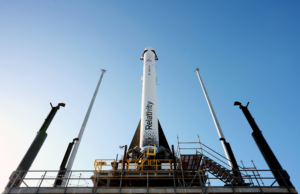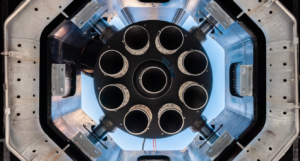
Dream Chaser Tenacity Is Officially Complete
After decades of development and testing, the first Dream Chaser test article is complete and preparing for its maiden flight. In the past, the Space Shuttle was a staple within the industry flying over 100 times both with crew and cargo. Its unique design allowed it to be reused after landing on a runway. However, it was far from perfect, and was eventually retired in 2011.
Now, a new modern spaceplane is getting ready to lift off and mark the beginning of Dream Chaser’s busy future. This includes multiple variants, meant for crew and cargo, a smaller size, folding wings, and a host of features hoping to improve on past designs.
This news from Sierra Space comes just in time as they prepare for a launch in only a few months from now. Here I will go more in-depth into the completion of Dream Chaser Tenacity, the final steps before launch, why this mission is so important, and more.
Tenacity Is Complete

Dream Chaser was publicly announced all the way back in 2004. At the time the company working on the project wasn’t even Sierra Space, it was a different group called SpaceDev. This being said, a few years after starting the project, in 2008, SpaceDev and the Dream Chaser spaceplane were acquired by the Sierra Nevada Corporation, the parent company of Sierra Space. Since then, we have seen different tests and progress as the company developed and assembled this vehicle.
This morning however we got arguably the biggest update in the project’s over decade-long development. Here, Sierra Space tweeted saying, “We have arrived at a profound milestone in both our company’s journey and our industry’s future,” said CEO Tom Vice. Tenacity, the first vehicle in the Dream Chaser fleet is complete, and will ship to NASA’s Neil Armstrong Test Facility in the coming weeks.” This included an image of the entire Sierra Space team with Tenacity complete in the background.
In a different closer-up image provided by the company, we can see a bunch of different details such as the vehicle’s thrusters at the front. The folded wings needed to fit within the fairings of United Launch Alliances Vulcan rocket can also be seen in addition to thousands of thermal tiles spread across the body.
In a company statement Sierra Space said, “Today we proudly revealed the fruit of years of passionate determination, countless breakthrough innovations, and relentless commitment – the remarkable Dream Chaser spaceplane.” Sometime in the next few weeks, this vehicle will ship to NASA’s facility in Ohio for final testing before launch approval. Interestingly, Tenacity has already been to this facility before where it completed some checkouts. Specifically, earlier this year, Sierra Space and NASA successfully completed a joint thermal vacuum demonstration test at the facility. The test was performed in preparation for integrated Dream Chaser spacecraft environmental tests, which are only weeks away.
The test validated the ability of NASA’s In-Space Propulsion Facility to achieve both hot and cold temperature extremes under vacuum, along with a collection of critical data needed to increase accuracy/fidelity of models used to predict thermal conditions & vehicle performance. It went well and now later this month a few more tests will be completed. Once testing is done, assuming the results are good, Dream Chaser Tenacity will be ready to ship to Florida to be integrated into Vulcan.
This first launch will see Tenacity liftoff before it attempts to reach and berth to the International Space Station. It will bring cargo and stay docked at the station for a few months before separating and attempting to reenter the Earth’s atmosphere. If successful, it will then attempt a runway landing completing the first mission. Back in January 2016, NASA announced that Dream Chaser had been awarded one of the CRS-2 contracts and committed to purchasing a minimum of six resupply missions to the ISS. This initial mission is mainly a demo and is meant to prove the capability and operations of this new vehicle. If things go well, we can expect a ramp-up in Dream Chaser flights as the company completes its contracted missions with NASA.
In terms of a specific launch date for this maiden flight, there are still a few unknowns. Most recently the company was targeting December, however, the vehicle that Dream Chaser is launching on (ULA’s Vulcan) has faced quite a few delays. The first launch of Vulcan, which will not be carrying Dream Chaser, is targeted for Christmas Eve, or December 24th. The second Vulcan launch will be the one carrying Tenacity. For this reason, even if the first Vulcan flight goes perfectly, the second launch won’t happen until January or February of 2024 at the earliest.
In addition, a few months ago, Tom Vice, chief executive of Sierra Space, said the company was continuing to work towards a first launch of its cargo Dream Chaser vehicle as soon as December. Most importantly, he commented that he expected Dream Chaser to be fully integrated with its launch vehicle in “the December timeframe” and launch in a window that extends into early February. This also matches up with the time needed for Sierra Space and NASA to complete the final testing.
A Modern Spaceplane

The last time we saw a spaceplane launch was back in 2011, during the final Space Shuttle mission. Even though Tenacity is also a spaceplane, it is very different than the Shuttle. The Dream Chaser spaceplane is a multi-mission vehicle meant to support a variety of LEO needs. It can be customized for both domestic and international customers via vehicle configuration, launch site, destination, landing site, duration, and a host of other variables.
Sierra Space is quoted saying, “Tenacity represents an uncrewed spiritual successor to the space shuttle, and at 30 feet (9 meters) long, it’s roughly a quarter of the total length of the space shuttle orbiters. Tenacity’s pressurized volume is 33 cubic meters (including both the spaceplane and the cargo module). This makes the spaceplane more sustainable and easier to maneuver, but it also assists with gentle 1.5g runway landings – ideal for fragile cargo.
Compatible with a wide variety of launch vehicles, Tenacity will be launched in a stowed configuration inside a 5m payload fairing, making it significantly more flexible by reducing ascent loads on the vehicle and protecting the vehicle from debris. Back in 2017, Sierra Space conducted a test flight where the team tested the Dream Chaser hardware during an autonomously conducted atmospheric flight. On descent over the California desert, the Dream Chaser test vehicle autonomously deployed its landing gear, touching down on the runway at NASA’s Armstrong Flight Research Center in Edwards, California, demonstrating the spaceplane’s unique lifting body design.
As for in-space maneuvering, Tenacity will utilize internally developed thrusters with three different thrust modes. In addition to the spaceplane itself, the company will attach a large module to the back of the vehicle named Shooting Star. The Shooting Star cargo module is a flexible 15-foot transport and cargo vehicle to be used as an attachment to the Dream Chaser spaceplane. Dream Chaser, with the help of Shooting Star, can deliver up to 12,000 pounds of pressurized and unpressurized cargo to low-Earth orbit.
As for the heat shield, thousands of unique individual tiles are attached to each portion of the spaceplane. The difference between black and white is an additive to the outer glass coating which helps balance heat absorbed. Each tile is unique in design, and differs in size, shape, thickness, and density. In the past, the Space Shuttle used tens of thousands of tiles which presented a few issues. However, Sierra Space is quoted saying, “SNC engineers have been able to update the TPS tiles from what was used during NASA’s shuttle program with more innovation, better technology, and utilizing lessons learned. They use more modern manufacturing techniques to increase strength and reduce cost. Another difference between the tiles is Dream Chaser tiles are about 10 inches by 10 inches, while those on the shuttle were six inches by six inches. Dream Chaser tiles are stronger and lighter weight than those used during the shuttle program and meet all Micro-Meteroid Orbital Debris (MMOD) requirements to ensure safe entry, descent, and runway landings for crewed or cargo missions. These among other changes are intended to make the tiles even more reliable and easier to refurbish.
Adding to the upcoming physical testing of Tenacity, Sierra Space has also been training crews that will be on the ISS when the vehicle arrives. In this case, multiple NASA astronaut crews have visited Sierra Space facilities to undergo detailed training on understanding the vehicle, rendezvous and proximity operations, hardware, and cargo transfer scenarios in anticipation of Dream Chaser deliveries to the ISS. This training is conducted by Sierra Space subject matter experts and includes classroom training and training inside a full-size mock-up of Dream Chaser. This training has been completed with a few SpaceX crews that will launch on Dragon, and spend a few months on the station. All of which in preparation for the return of spaceplanes, and the maiden flight of Dream Chaser Tenacity.
Conclusion
Dream Chaser Tenacity is officially complete and only needs to complete some final testing before it’s shipped to Florida and integrated for flight. This one mission has been decades in the making after many years of development and testing. If successful, we can expect a ramp-up in flights and the return of frequent spaceplane missions within the industry. We will have to wait and see how it progresses and the impact it has on the space industry.



